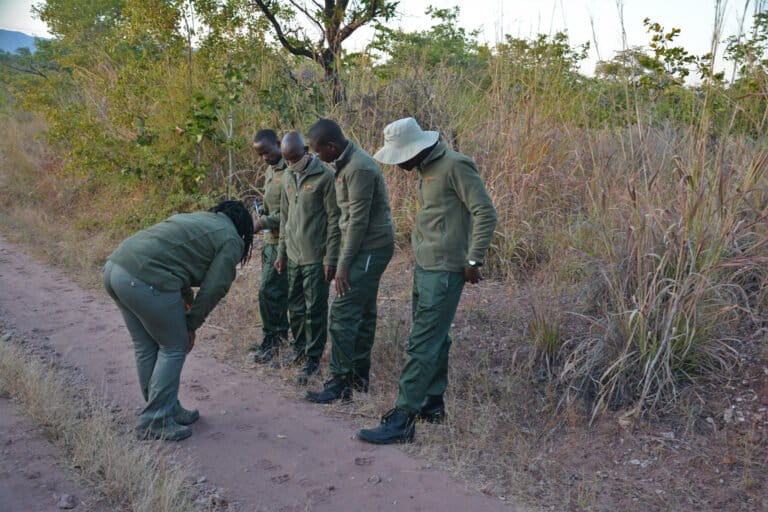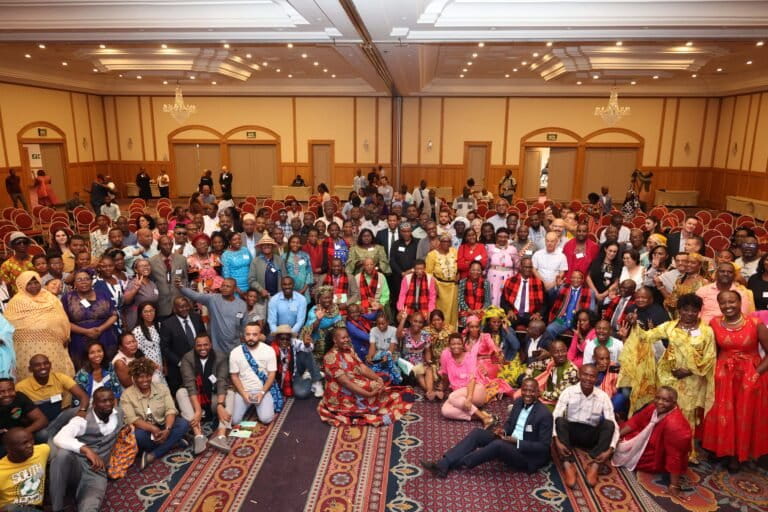By Victoria Scheneider Via Mongabay
Hundreds of Indigenous and local community groups, conservation organizations, governments and policymakers gathered to strategize how communities can play a bigger role in African conservation efforts, which are typically dominated by big international NGOs.
However, the outcomes of the congress were vague, and some participants concluded that the dependence on large NGOs and policymakers, through equitable partnerships, was needed.
Organizers say this congress is a starting point to elevating community voices in Africa while they’ve chosen a new alliance, the Alliance for Indigenous People and Local Communities for Conservation in Africa (AICA), to be a representative voice for communities across the continent.
Last week, communities and conservation stakeholders from across the African continent gathered in Windhoek, Namibia, to attend the first Indigenous Peoples’ and Local Communities’ Conservation Congress.
“IPLCs themselves organized this congress, set the agenda and led the discussions,” said Patrick Kipalu, Africa director of the Rights and Resources Initiative (RRI). “It was a space where decision-makers, NGOs, donors, conservation organizations and communities came together to find common solutions.”
The conservation agenda in Africa, and ensuing conferences, are typically led and directed by big international NGOs, or BINGOs, and a global network of scientists and policymakers. However, this marked the first conservation congress where communities were in the driving seat.
Organized by the Alliance for Indigenous People and Local Communities for Conservation in Africa (AICA) and the U.S.-based organization RRI, the event hosted local community members, policymakers, representatives of regional and international conservation organizations and NGOs.
Their mission was to follow up on the 2022 Africa Protected Areas Congress in Kigali, itself a first, which asked crucial questions in the face of global goals to protect 30% of land by 2030 — how to include communities in the expansion of protected areas and what a sustainable future looked like in Africa. The Kigali call to action became the fruit of the congress and highlighted the role of Indigenous peoples and local communities (IPLCs) in conservation and the goal to end the displacement of communities for the creation of protected areas.
We’re trying to turn the Kigali call to action into reality, Kipalu told Mongabay.
However, there was neither a written document nor a call to action launched at the end of this IPLC congress. While more work will be required on the local, regional and national levels, there was a consensus among participants that AICA will be the organization to play a vital role in amplifying IPLCs’ voices in Africa.
“The vision for the alliance is to be a body that unites the voice of Indigenous peoples and local communities and mobilizes resources for community conservation projects, capacity building and the creation of country chapters in order to develop action plans,” concluded Loupa Pius from the Coalition of Pastoralist Civil Society Organisations (COPACSO) in Uganda, on the final day of the congress.
But ultimately, said Kipalu, the role that IPLCs can play is going to depend on whether and how large NGOs and policymakers are willing to adjust their systems to ensure that IPLCs are supported.
And we need to discuss how to leverage what communities are already doing to support a continental conservation agenda, said Kipalu. “When you go into any small village in Africa, you will find that people conserve as a way of living, not because they were called to ‘conservation.’”

A starting point?
José Monteiro, who is a member of the Community Leaders Network, which co-hosted the congress, said Windhoek was “a starting point for Africa to define its own policy framework — one that works for Africa.”
Moving forward, according to Monteiro, IPLCs and their representatives need to strengthen governance structures starting in the communities, via country levels and regions, all the way to the continental level, with AICA as the representative body of IPLCs.
“We need to build an institution that is not elite-captured but built from the bottom up,” he said about AICA, which was formed in the months following the Kigali declaration. Details about who was part of AICA were not clarified.
The three-day event covered topics such as human-wildlife conflict, ways to redress grievances, the improved participation of women and youth in conservation, recognizing customary land rights, challenging land appropriation rooted in colonial regimes and legal reforms to strengthen the rights of IPLCs in the creation of protected areas. The congress was also an opportunity for the communities, which came from 43 African countries, to demonstrate their conservation practices and traditional knowledge systems.
“The gathering was a sign that communities in Africa are together in this and working towards speaking with one voice,” said Monteiro, also from ReGeCom, a Mozambican organization promoting community-based natural resources management.
Historically, governments and large international conservation organizations have approached conservation from the top down. Indigenous peoples and local communities have been subject to human rights violations in the name of conservation, such as forced displacement and the loss of traditional land.

“Whilst much progress has been made through international conventions like the U.N. biodiversity agreement, and increased recognition and exposure of IPLCs through research and conferences, greater support and implementation of this is still required on the ground,” Wayne Stanley Rice, a South African environmental social scientist, told Mongabay.
“Whether leading or supporting conservation initiatives, IPLCs need to be inclusively involved in all phases of conservation from planning and decision-making through to implementation, monitoring and ongoing governance activities.”
When there’s a clash in values and approaches between communities and NGOs, the latter at times using “aggressive methods to do conservation and working against people,” said Moreangels Mbizah, founder of Wildlife Conservation Action, a nonprofit conservation organization in Zimbabwe dedicated to supporting communities.
Many IPLCs still face barriers, especially when it comes to being legally recognized and accessing tenure rights. In Africa, local communities manage or legally own only 6% of registered protected areas. The Kigali call to action acknowledged these challenges, along with the human rights abuses faced when displacing communities and called for the rights of IPLCs to be recognized, respected and supported.
“We want to work together with governments and policymakers to prevent communities from experiencing the same injustices and human rights violations of the past,” said Kipalu.


Comments are closed.